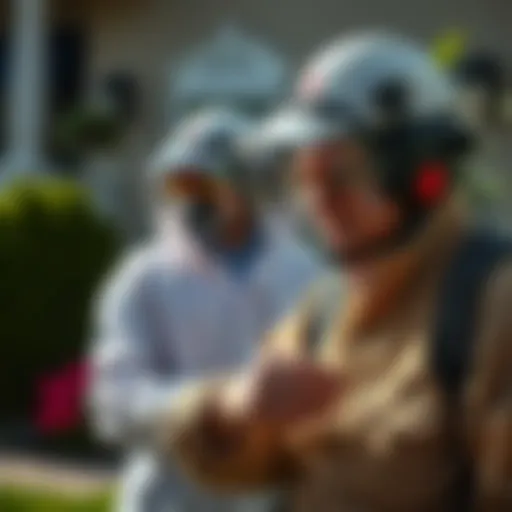Effective Dust Treatments for Bed Bug Control
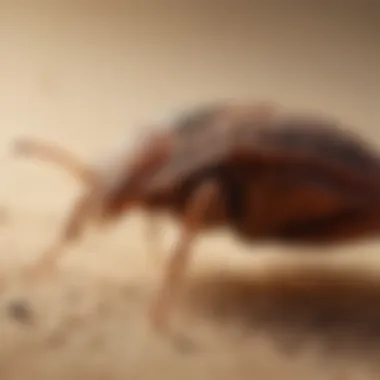

Intro
Bed bugs pose significant challenges for homeowners due to their resilience and ability to multiply rapidly. As these pests are often found in bedding, furniture, and other household areas, understanding their biology and behavior is crucial for effective management. This article aims to explore dust treatment for bed bugs, a method that has gained attention for its effectiveness.
Dust formulations serve as a key tool for pest control, particularly when used alongside other strategies. This article will delve into the relationship between pest identification and appropriate treatment methods. A comprehensive approach is necessary, especially when considering the safety and efficacy of various treatments available in the market.
As we navigate through the intricacies of dust treatment, readers will learn about specific dust formulations, their application techniques, and the critical importance of preparing the environment before treatment. Each aspect discussed will cater to the needs of homeowners, pest management professionals, and eco-conscious individuals, ensuring a holistic understanding of bed bug control.
Understanding Pests
Definition of Pests
Pests are organisms that cause disturbance to human activities and environments. This term encompasses a variety of species, which may include insects, rodents, and even fungi. Bed bugs, in the context of pest management, are classified as parasitic insects that thrive on feeding off human blood. Their presence sets off nuisances that affect not only physical health but also mental wellbeing.
Importance of Pest Identification
Identifying pests accurately is fundamental to managing infestations. Each species exhibits distinct behaviors and life cycles, leading to varying requirements for effective control strategies. Bed bugs, for instance, reproduce quickly and can be difficult to eliminate without targeted methods. Therefore, understanding their habits, such as hiding in dark crevices during the day and emerging at night to feed, aids significantly in mitigating infestations.
Identifying infested areas also connects directly to treatment choices. Utilizing dust treatments effectively requires awareness of where bed bugs are likely to hide, thus guiding precise application.
Dust Treatments for Bed Bugs
Dust treatments have been established as a reliable approach in controlling bed bug populations. In general, dust formulations consist of insecticides designed to adhere to surfaces and remain effective over time. These dusts can reach cracks and crevices that liquid treatments may miss, providing critical coverage in target areas.
When selecting dust treatments, look for formulations that contain active ingredients such as diatomaceous earth, boric acid, or pyrethroids. Each ingredient works through different mechanisms. For instance, diatomaceous earth operates by damaging the insect's exoskeleton, leading to dehydration over time.
"The effectiveness of dust treatments lies in their ability to penetrate the hard-to-reach habitats of bed bugs."
Effective Application Techniques
Applying dust treatments properly ensures the best results. Here are effective application techniques:
- Preparation: Start by decluttering the area. Remove bedding and inspect where you’re likely to find bed bugs.
- Target Areas: Apply the dust in known hiding places such as mattress seams, furniture joints, and behind baseboards.
- Powder Application: Use a puffer or duster for controlled dispersion of the dust. Avoid excessive amounts, as this can create a barrier that bed bugs may avoid.
- Sealing Cracks: After treatment, consider sealing potential entry points. This reduces the chance of bed bugs returning.
Safety considerations are paramount when using any pest control product. Wearing a mask and gloves during application protects against inhalation or skin contact with powders.
Combining Treatments for Optimal Results
Integrating dust treatments with other pest management strategies can enhance control effectiveness. Consider approaches such as:
- Heat Treatment: High temperatures can kill bed bugs and their eggs. Using heat along with dust treatment may yield better results.
- Insect Growth Regulators (IGR): These compounds disrupt the life cycle of bed bugs, preventing them from maturing into reproductive adults. When combined with dust treatments, IGRs can significantly decrease population growth.
- Regular Monitoring: After the initial treatment, continue to monitor areas for signs of bed bugs. Early detection increases chances for successful control.
By encompassing a variety of strategies, individuals can better manage the complexities of bed bug infestations. The goal in pest control is always to strive for complete eradication with minimal impact on the living space. With attentiveness to preparation and follow-up, dust treatments can form an integral part of an effective pest management plan.
Understanding Bed Bugs
The topic of understanding bed bugs is crucial in managing their infestations. A deep comprehension of these pests can help tailor effective dust treatments and other strategies. Bed bugs are not just a nuisance; they can cause discomfort and sleeplessness. Knowing their biology, behavior, and signs of their presence equips homeowners with the knowledge needed for early detection and control. This understanding fosters a proactive approach in dealing with possible infestations instead of a reactive one.
Biology of Bed Bugs
Bed bugs, scientifically known as Cimex lectularius, are small, flat, wingless insects. They are approximately 5 to 7 millimeters long and can easily be mistaken for apple seeds. These pests are nocturnal, feeding mainly on human blood at night. Their bodies are brownish, and they develop a reddish hue after a blood meal. Bed bug eggs are tiny, white, and about 1 millimeter in size, making them hard to spot. The life cycle consists of three stages: egg, nymph, and adult. Each adult female can lay up to five eggs each day. Their ability to reproduce rapidly makes understanding their biology vital for effective management.
Behavior and Habitat Preferences
Bed bugs prefer warm environments close to their food source, often residing in crevices and seams of furniture, mattresses, and walls. They are adept at hiding during the day, which complicates detection. In shared living spaces such as apartments or dormitories, bed bugs can easily spread from one unit to another. Their behavior of traveling on personal items or luggage during travel contributes to new infestations, underscoring the need for vigilance when returning home from trips. Understanding these behaviors aids homeowners in identifying potential risk factors and can inform their pest management strategies.
Signs of Infestation
Identifying signs of a bed bug infestation early is key to effective treatment. Common indicators include:
- Bites: Small, itchy welts appearing on the skin. Often occur in clusters or linear patterns.
- Exoskeletons: Shed skins found in locations where bed bugs are hiding.
- Fecal stains: Small dark spots on bedding or furniture, indicating where bed bugs have fed.
- Eggs and egg casings: May be found in hidden areas, hard to see due to their size.
Effective monitoring and detection of these signs can reduce the chances of a larger infestation.
Recognizing these symptoms promptly allows for quick intervention, which can significantly affect the ability to control the problem effectively.
Pest Control Strategies
Pest control strategies form a crucial foundation in the fight against bed bugs. These approaches combine tactics that not only focus on eliminating the pests but also understand their behaviour, biology, and ecology. Effective pest control strategies are multi-faceted, which can ensure more thorough and lasting results. The significance of these strategies stems from their potential to minimize the reliance on a single method, which could be ineffective against resilient populations of bed bugs.
In this article, the focus will be on outlining various components of pest control related to bed bugs, specifically in the sections on Integrated Pest Management, chemical, and non-chemical methods, along with the importance of combining these methods. This exploration illuminates how integrated tactics can provide a more robust solution for dealing with infestations.
Integrated Pest Management Overview
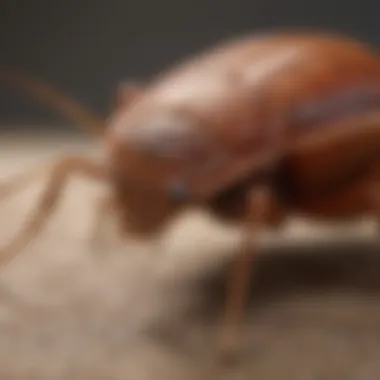

Integrated Pest Management (IPM) is an effective approach that combines several management techniques. It encompasses biological, cultural, physical, and chemical controls for a holistic pest management system. The main goal of IPM is to reduce or eliminate the use of chemicals while still achieving the desired effects against bed bugs.
IPM strategies may include:
- Regular inspections of living spaces
- Monitoring and tracking bed bug populations
- Sanitation measures to eliminate conducive environments
- Education for inhabitants about bed bug prevention
Emphasizing prevention through responsibility and awareness can make a significant impact. By understanding bed bugs and their behaviours, informed decisions can be made to counteract infestations effectively.
Chemical and Non-Chemical Methods
When it comes to pest control for bed bugs, methods can broadly be categorized into chemical and non-chemical strategies.
Chemical Methods
Chemical treatments involve the application of insecticides specifically designed to target bed bugs. Some commonly used insecticides include pyrethroids and neonicotinoids. These substances can efficiently eliminate active infestations when applied correctly. However, it should be noted that some bed bug strains have developed resistance to certain types of chemicals. This highlights the potential need for an ongoing assessment of effectiveness.
Non-Chemical Methods
Non-chemical strategies include the use of products like diatomaceous earth or silica gel, which operate by physically harming the bugs upon contact. Heat treatment is another non-chemical method that involves bringing infested areas to high temperatures, killing eggs and adult bugs alike. Such measures enable controlling infestations while also minimizing chemical exposure to household members and pets.
Importance of Combining Methods
The ultimate effectiveness of pest control strategies for bed bugs lies in the integration of different methods.
"A combination of methods leads to a more sustainable approach to pest management."
When chemical and non-chemical methods are synergized, it can create multiple barriers against bed bugs. Furthermore, rotating different types of treatments can prevent resistance development and ensure long-term success.
This multifunctional approach not only leads to a better outcome in addressing current infestations but also plays a significant role in preventing future occurrences. Utilizing a comprehensive pest control strategy can enhance the overall management of bed bugs and facilitate a more controlled living environment.
Dust Treatment Overview
Dust treatment serves as a pivotal method in the battle against bed bug infestations. Understanding the nuances of this approach is crucial for homeowners and professionals dealing with these resilient pests. Dust treatments involve applying specific insecticidal dusts, which can penetrate the hiding spots of bed bugs more effectively than other methods. This aspect of treatment is frequently overlooked yet incredibly important due to the unique biology and behavior of bed bugs.
Dust treatments have their own benefits, limitations, and considerations. These factors dictate when and how to utilize dust treatments effectively. Key elements include the formulation of dust, the method of application, and knowing the ideal conditions for treating effects. With these considerations in mind, a more informed choice can be made about pest control measures.
What is Dust Treatment?
Dust treatment refers to the application of fine insecticidal powders in areas where bed bugs are likely to be present. It is designed to target bed bugs directly or indirectly, by adhering to their bodies as they crawl over the treated surfaces. This method takes advantage of the pest’s behavior because bed bugs tend to inhabit tight spaces, such as cracks and crevices.
The dust can include various active ingredients that disrupt the nervous system of the insects. Common examples of dust formulations include pyrethroids and silica gel. Each type of dust works differently, and the choice may depend on the situation and safety considerations.
Advantages of Dust Treatments
Dust treatments possess several advantages that can enhance their effectiveness in managing bed bugs. Some of these include:
- Long Residual Effect: Unlike liquid treatments, dusts can last a long time on surfaces, continuing to kill bed bugs for weeks after application.
- Ease of Application: Dust can be applied in hard-to-reach areas without much preparation required.
- Minimal Disruption: Dust treatments are less invasive and often require less time to apply than thorough liquid treatments.
- Targeting Specific Areas: They allow for precision in targeting cracks, crevices, and other hiding spots typically favored by bed bugs.
These benefits highlight why dust treatment is often a preferred choice among pest control strategies. However, it is essential to consider the limitations and any potential drawbacks.
Limitations and Considerations
Despite their advantages, dust treatments have limitations that must be taken into account:
- Limited Efficacy Alone: While effective, dust treatments are generally not sufficient on their own for a full control strategy. They should be part of an integrated pest management approach.
- Environmental Concerns: The dust can pose risks to non-target organisms, including pets and beneficial insects, if not applied correctly.
- Potential for Resistance: Over time, bed bugs can develop resistance to certain dust formulations, reducing their effectiveness.
Because of these limitations, it is essential to carefully evaluate the condition of the infestation and not to rely solely on dust treatments. \n\n> "An effective strategy often includes the combination of various methods to achieve a sustainable solution to bed bug infestations."
In summary, dust treatment provides an effective, targeted approach to controlling bed bugs, complemented by an understanding of its strengths and potential weaknesses. Combining dust treatments with other strategies enhances their effectiveness and offers a well-rounded approach to managing these persistent pests.
Effective Dust Formulations
Effective dust formulations play a crucial role in controlling bed bug infestations. The proper selection and application of these formulations can enhance the effectiveness of treatments. It is essential to consider the specific characteristics of bed bugs, as well as the unique environmental conditions of the treated area. Dust treatments provide targeted action, allowing for precise application in hard-to-reach locations where bed bugs tend to hide.
These formulations not only kill adult bed bugs but may also help in targeting eggs or nymphs, which can be vital in breaking the cycle of infestation. The versatility of dust treatments allows them to be combined with other treatments, leading to synergy in pest control measures.
Insecticidal Dusts
Insecticidal dusts are the most commonly used dust formulations for bed bug treatment. They operate through a simple mode of action where bed bugs come into contact with the dust, which disrupts their physiological function, leading to their death. Common active ingredients found in these dusts include pyrethroids, which are known for their fast-acting properties.
When selecting insecticidal dusts, it is essential to read product labels carefully. Many formulations target various stages of bed bugs' life cycle. Some may be effective against resistant strains. Household exposures are relatively low, making these products suitable for residential use if handled correctly. Advantages of insecticidal dusts include:
- Long residual activity, ensuring ongoing protection after application.
- Less likelihood of repellent effects, making it easier for bed bugs to come into contact with the treatment.
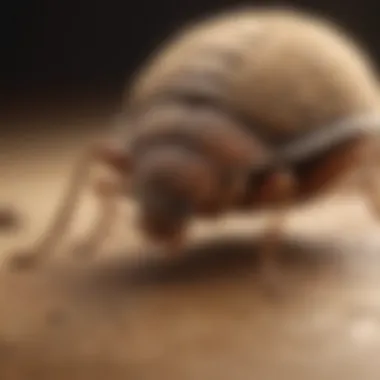

Silica Gel and Diatomaceous Earth
Silica gel and diatomaceous earth are alternative dust formulations that offer an environmentally friendly approach to bed bug control. Silica gel works by dehydrating bed bugs, leading to their eventual death. When bed bugs come into contact with silica, it absorbs moisture from their bodies, causing them to die over time. This method is effective because it does not rely on chemical toxins.
Diatomaceous earth is similar in function but consists of fossilized algae. This dust also dehydrates insects by damaging their waxy exoskeleton. Both silica gel and diatomaceous earth can be applied in cracks and crevices. They are particularly useful for those who prefer non-chemical options for bed bug treatment.
Benefits of using silica gel and diatomaceous earth include:
- Minimal environmental impact compared to chemical insecticides.
- Safe for use around pets and children when applied properly.
- Available in various forms, allowing for flexible application.
Dust with Minimal Environmental Impact
Selecting dust formulations with minimal environmental impact is increasingly important. Homeowners are more aware of the ecological consequences of pest control methods. Balanced approaches ensure safety for family members and pets while maintaining effective pest control.
Products labeled as 'green' or 'eco-friendly' may use natural ingredients that have been proven effective against bed bugs. These include ingredients derived naturally, which further reduces the carbon footprint associated with synthetic chemical production. It is essential to evaluate the effectiveness of these options while also ensuring safety in the household.
Considerations for choosing environmentally friendly dusts include:
- Ensuring the product is registered with relevant authorities, confirming its efficacy and safety.
- Understanding the specific treatment objectives and tailoring the selection based on individual needs and preferences.
In summary, choosing effective dust formulations represents a critical step in managing bed bug infestations. The selection of insecticidal dusts, or more environmentally friendly options like silica gel and diatomaceous earth, plays a significant role in a comprehensive pest management strategy.
Application Techniques
Understanding how to properly apply dust treatments is crucial in effectively managing bed bug infestations. This section emphasizes the significance of application techniques because they determine how well the treatment penetrates target areas. If applied incorrectly, even the best dust products might be ineffective. Therefore, employing correct methods enhances overall treatment success.
Preparation Before Dusting
Before initiating dust treatment, careful preparation is necessary. Begin by decluttering the treated areas. This makes it easier to access potential hiding spots for bed bugs. Items like clothing, books, and other possessions should be carefully removed or organized to prevent disruption during dusting. After decluttering, vacuum the area thoroughly. This step helps to remove debris, dead insects, and eggs, giving the dust a higher chance to reach bed bugs directly. Be sure to dispose of the vacuum bag immediately to avoid recontamination. Finally, it is essential to read the instructions provided with the dust treatment product of choice. Understanding application dos and don’ts is key to effectiveness and safety.
Application Methods and Equipment
Various methods can be employed during application. Using a hand duster is usually an effective way to control the amount of dust dispensed. Hand dusters provide precision in targeted areas, minimizing waste and maximizing effectiveness. Alternatively, a power duster can be utilized for larger spaces. This method offers a broader application, ensuring coverage in hard-to-reach areas.
When applying dust, always keep the duster away from your body to prevent accidental exposure. Apply dust in a thin layer in cracks and crevices where bed bugs commonly hide. Focus on areas such as the seams of mattresses, baseboards, and wall cracks. The key to successful application is ensuring the dust is applied uniformly to provide maximum protection against bed bugs.
Target Areas for Treatment
Identifying and treating the right areas effectively is pivotal. Bed bugs tend to hide in narrow spaces during the day, so paying attention to specific locations is crucial for effective treatment. Common target areas include:
- Mattresses and Box Springs: Pay special attention to seams and folds.
- Bed Frames and Headboards: Inspect all joints and cracks.
- Furniture: Areas around cushions and any potential hiding spots like underneath furniture.
- Carpets and Rugs: Bed bugs can also inhabit the fibers, especially close to walls and beds.
- Electrical Outlets and Appliances: These can serve as resting spots and should not be overlooked.
Ensuring thorough and strategic application in these locations increases the likelihood of eliminating any presence of bed bugs.
"Proper application techniques significantly enhance your ability to manage bed bug infestations effectively. Without thoughtful diligence to these methods, even the most potent dust treatments may fail."
By adhering to systematic preparation, utilizing correct application methods, and targeting specific areas, one can significantly optimize the efficacy of dust treatments against bed bugs. Maintaining awareness in these processes is part of a critical strategy in pest management.
Post-Treatment Follow-Up
Effective pest management does not conclude with the application of dust treatments. Post-treatment follow-up is a critical aspect of controlling bed bug infestations. This phase involves systematic monitoring, reassessing the effectiveness of applied strategies, and ensuring the environment remains inhospitable to these pests. Neglecting this part can lead to future problems, as bed bugs can quickly re-establish themselves if any survivors remain.
Routine inspection should be scheduled to determine if bed bugs have resurfaced. Utilizing monitoring tools like sticky traps can be beneficial for this purpose. It is vital to inspect not just the treated areas but also adjacent spaces, as these insects are known to spread easily.
Adopting proactive measures post-treatment can significantly strengthen the battle against bed bugs. Here, we break down key elements to consider during this crucial follow-up phase.
Monitoring for Bed Bugs
Monitoring entails a regular and thorough inspection of the affected areas. Look for signs such as:
- Live bed bugs
- Molted skins
- Small blood stains on bedding or furniture
- Dark spots from fecal matter
Install bed bug monitors or traps in strategic locations to detect any re-emerging populations. Frequent visual inspections of mattress seams, furniture crevices, and other potential hideouts provide insights into any existing or new infestations. This step is essential, especially during the first few weeks after treatment.
When to Retreat
A thoughtfully timed retreatment can be a determining factor in preventing a resurgence of bed bugs. If monitoring indicates that bed bugs are still present or new ones have appeared within weeks of the first treatment, it’s prudent to consider re-application of dusts or exploring additional methods. Typically, if bites or signs are observed, initiating a retreatment within two weeks is advisable. Being vigilant within this timeframe is crucial in disrupting the life cycle of these pests before they can multiply.
Maintaining a Bed Bug-Free Environment
Sustaining a bed bug-free environment requires ongoing diligence and lifestyle adjustments. Here are practices to consider:
- Declutter living spaces to reduce hiding spots. Keep items off the floor and in sealed containers.
- Regular cleaning of bedding and upholstered furniture can minimize dust and debris that attract or house bed bugs. Wash bedding in hot water and dry on high heat to kill any potential bugs or eggs.
- Encasing mattresses and box springs in bed bug-proof covers can prevent any infestation from being re-established or spreading to the bed.
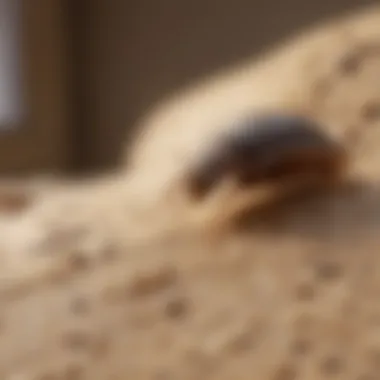

"The battle against bed bugs is not just about eradication, but about prevention and vigilance."
Continuous monitoring and adjustments to household habits are essential in this fight. Diligence can lead to a sustainable bed bug-free home.
Safety Considerations
When dealing with bed bugs, the safety of household members, pets, and even the environment should be a primary concern. While dust treatments can effectively manage infestations, understanding how to use these products safely is essential. Proper knowledge of safety considerations helps ensure that the process is effective without causing harm.
Protecting Pets and Family
In homes with pets and children, safety measures become even more critical. Bed bug dust, like any pest control product, may pose potential risks if pets or young children come into direct contact with it. Before applying any dust treatment, it is wise to remove pets from the vicinity. Consider placing them in a different room or an outdoor space during the application process. This measure prevents accidental ingestion or inhalation of the dust.
Once the application is complete, allow sufficient time for the dust to settle. This waiting period ensures that the treatment minimizes exposure risks. Afterward, ensure the treated area is thoroughly vacuumed to remove any excess dust. Lastly, educate family members about what bed bug treatments involve. This transparency fosters an environment where everyone understands the importance of safety during pest management.
Handling and Storing Dusts
Safe handling and storage of pest control materials are equally important. Always follow the manufacturer’s instructions regarding usage and storage conditions. Here are some practical tips:
- Use protective gear such as gloves and masks when applying dust treatments.
- Store dusts in their original containers with labels intact. This practice ensures clear communication regarding the contents.
- Keep dust treatments in a secure place, out of reach of children and pets. A locked cabinet is advisable.
- Avoid mixing different dust treatments, as this can lead to unpredictable results or increased toxicity.
Maintaining these storage protocols helps prevent accidents and ensures effective treatment application.
First Aid for Exposures
Even when safety measures are in place, accidental exposure can still occur. Understanding first aid protocols can be helpful when needed. If someone has contact with the dust, the following steps should be taken:
- Immediate Rinse: If the dust comes into contact with the skin, rinse the affected area thoroughly with water for at least 15 minutes.
- Inhalation Precautions: If inhaled, remove the person from the area and seek fresh air. If respiratory distress occurs, contact medical authorities.
- Seek Medical Help: For any serious reactions or concerns regarding the material used, consult a medical professional.
It’s crucial to have the product’s safety data sheet readily available for reference when seeking medical advice.
Being prepared for potential accidents fosters a safe environment. By understanding proper safety precautions, the effectiveness of dust treatment methods can be maximized while ensuring the well-being of every member of the household.
Comparative Effectiveness
Understanding the comparative effectiveness of dust treatment against other pest control methods is crucial for homeowners looking to manage bed bug infestations. This section delves into two essential comparisons: dust treatments versus liquid treatments, and the cost-effectiveness of these options. Having this knowledge allows homeowners to make informed decisions based on their specific situations, resources, and infestation levels.
Dust Treatment vs. Liquid Treatments
Dust treatments and liquid treatments are two common strategies for combating bed bugs. Each has its strengths and weaknesses.
Dust Treatments:
- Mechanism: Bed bugs come into contact with dust particles, which can adhere to their bodies. This leads to dehydration or death.
- Longevity: Dust can remain effective for longer periods, potentially weeks.
- Application: Dust can penetrate small spaces and hideouts better than liquids.
Liquid Treatments:
- Mechanism: These treatments typically involve spraying a liquid insecticide which can kill bed bugs upon direct contact.
- Speed: Liquid applications often provide faster knockdown of bed bugs.
- Wicking: Liquid has the advantage of soaking into surfaces, which may lure bed bugs to contaminated areas.
Both modes of treatment offer distinct advantages, and many experts suggest using a combination of both for maximum effectiveness. The choice may also depend on the infestation's severity and location within the premises.
Cost-Effectiveness Analysis
When addressing pest control, cost is always a significant factor for homeowners. Analyzing the cost-effectiveness of dust treatments compared to other options helps determine the most suitable methodology for budget-conscious individuals.
Factors to consider include:
- Initial Cost: Dust insecticides often have a lower upfront cost than liquid formulations.
- Application Frequency: Dust treatments require less frequent applications, potentially reducing long-term costs.
- Efficacy: The effectiveness of dust treatments may lead to fewer applications overall, saving money.
"Investing in effective pest management initially can prevent costly treatments and damage in the future."
Furthermore, combining dust treatment with other methods can enhance overall effectiveness and provide greater value for money. Homeowners should consider both the cost and the expected outcomes when choosing pest control strategies.
The End
In this article, we have explored the multifaceted nature of dust treatment as a viable approach to managing bed bug infestations. The use of dust formulations offers several benefits that make them an essential component of integrated pest management. This method allows for targeted applications in crevices and hard-to-reach areas where bed bugs tend to hide. Effectiveness is enhanced by the unique characteristics of certain dust products, such as insecticidal dusts which disrupt the biological processes of bed bugs upon contact.
In addition to their direct efficacy, dust treatments play a crucial role in the overall management of bed bug populations. They can complement other pest control strategies, providing a more cohesive response to infestations. Importantly, considerations regarding safety are paramount. Careful handling and storage of dust products minimize risks to humans and pets.
Furthermore, the effectiveness of dust treatments lies in their compatibility with both chemical and non-chemical methods. This versatility means that homeowners can use dust treatments alongside other techniques, enhancing their chances of achieving a bed bug-free environment.
"Employing a robust pest management strategy will ensure long-term success in controlling bed bugs."
By adopting dust treatments wisely and in conjunction with regular monitoring, individuals can vastly improve their ability to eliminate these pests. Therefore, understanding the nuances of dust treatment is not just about knowing the methods but also about integrating them into a comprehensive pest management plan.
Final Thoughts on Dust Treatment
Dust treatment for bed bugs stands out as a method that requires careful application and thorough understanding. While effective, it is essential to approach the use of dusts with knowledge of the specific formulations and techniques outlined in this article. When used correctly, dust treatments can significantly decrease bed bug populations, leading to a more peaceful and comfortable living environment.
The integration of dust treatments into broader pest control strategies represents an evolving understanding in the fight against bed bugs. Homeowners must weigh the pros and cons of this method, considering the specific context of their infestation. As bed bugs continue to pose a significant challenge, effective tools like dust treatment will remain relevant in the pest management landscape.
This article serves as a resource for both homeowners and professionals seeking to understand and effectively utilize dust treatments. Equipped with the information provided here, readers can make informed decisions to protect their homes from bed bug infestations.

